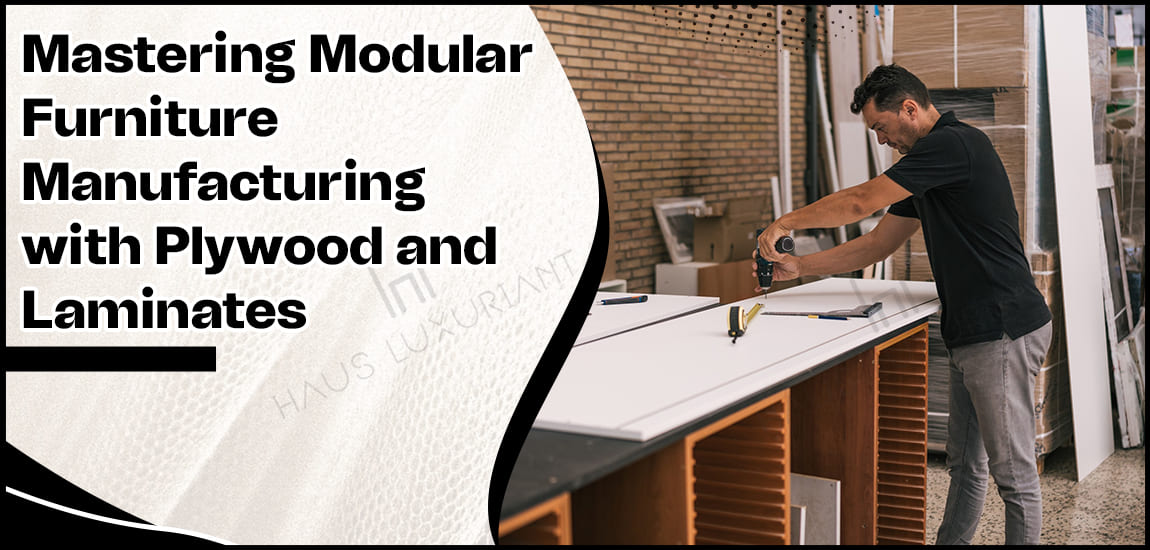
Modular furniture has gained popularity not only in homes but also cafes and offices. This is because it is functional, flexible, and enhances the interior. It has redefined designing and made setting up interior easy. The core of this furniture comprises of two materials: plywood and laminates. Both these materials together form the backbone of this durable and affordable furniture.
The manufacturers of modular furniture need to select material smartly, engineer precisely, and assemble efficiently. Here is a guide to help you understand the manufacturing process of this furniture using plywood and laminates. Let’s begin.
The manufacturers need to understand the process of creating modular furniture with plywood and laminates to deliver fine pieces as per need. Here are the steps to help you out.
Modular furniture has gained popularity as it helps in space optimization, making it best for compact urban homes and offices. It provides customization option which allows customers to get furniture as per their preference. Moreover, the panels are pre-drilled and ready to be assembled providing ease of transport and assembly. It offers contemporary aesthetics which suites the modern furniture tastes of today.
There are two important materials used in the creation of modular furniture: Plywood and Laminates.
Plywood forms the structural backbone of the modular furniture. It is engineered by bonding layers of wood veneer by applying heat and pressure. It offers moisture resistance, dimensional stability, higher strength-to-weight ratio and smooth surface for lamination. The grades of plywood commonly used comprise of marine plywood, BWR/BWP grade plywood, and commercial MR plywood. The marine plywood is used for high-end applications where maximum water resistance is required. Commercial MR plywood is for indoor furniture and BWR/BWP grade is for bathrooms, kitchens and humid atmosphere.
Laminates are basically decorative sheets which are placed onto plywood surfaces to give it color, texture and protection. The different types of laminates are high-pressure laminates, textured laminates, edge banding tapes, and glossy or matte finishes. The high-pressure laminates are durable, and heat resistant. The glossy finishes help in giving a visual theme while texture laminates represent stone, fabric and wood grain. The edge banding tapes are used for covering exposed panel edges, generally which are PVC or ABS based.
You can read also : High-End Office Furniture Trends in Jaipur
A systematic approach is required for designing modular furniture. It comprises of designing standardized units, panel-based construction, hidden hardware, and space planning. The standardized units comprise of drawers, shelves, and cabinets with uniform dimensions. The panel-based construction means building components from flat panels that are joined at right angles. The hidden hardware comprises of dowels, screws, and cam locks hidden inside for cleaner aesthetics. You can use CAD tools such as Sketch Up, AutoCAD or modular design software like polyboard to design your kitchen and manage space.
The modular furniture manufacturing workflow comprises of material cutting, edge banding, drilling and slotting, and laminate pressing. The process begins with material cutting using CNC router or panel saw followed by smoothening the edges using edge trimming machines. After cutting, the edges are protected and visually finished using automatic edge banders with glue pots or pre-glued tapes. Further, 32mm system is used for drilling hinges and shelf pins so that modular furniture is fixed in standard position. Lastly, laminate pressing is done using hot or cold press machines to ensure dust-free lamination.
The hardware must be carefully selected such that it is not only durable but also easy to use. There must be cam-lock system to ensure too-free assembly and telescopic channels, and soft-close hinges for providing better experience to the user. The adjustable legs, handles, and drawer locks make the furniture functional and visually appealing.
You can read also: Height Adjustable Desks vs Traditional Desks
The modular furniture assembly can be done either on-site or at factory. The assembly done at factory ensure quality and requires less installation effort and time. The on-site assembly provides flexibility and is therefore best for complex layouts. During the quality check, different aspects are checked such as design dimensions, surface finish consistency, sliding smoothness, edge banding adhesion and alignment and packaging.
Modular furniture requires careful packaging as it is considered as ready-to-assemble. The packaging process requires labelling of all parts, use of corner protectors, and addition of foam sheets for surface protection. An instruction manual is placed with the package describing all the necessary information about the parts.
Manufacturing modular furniture with plywood and laminates can profitable when done right. All you need to do is work smartly by combining modern design thinking with materials science and using efficient production process. The modular furniture is affordable, luxurious, and durable which makes it the best choice for customers.
Haus Luxuriant has been manufacturing modular furniture with great expertise since years. Here, you will get all type of designs to match with your space’s interior theme. The modular furniture is available here at affordable prices. If you have been seeking a reliable store to buy furniture, visit this best furniture manufacturer in Jaipur right away.
Connect with us today to get customized furniture solutions for your business. Fast quotes. Bulk orders. Trusted quality.
We respect your privacy. Your details are safe with us.